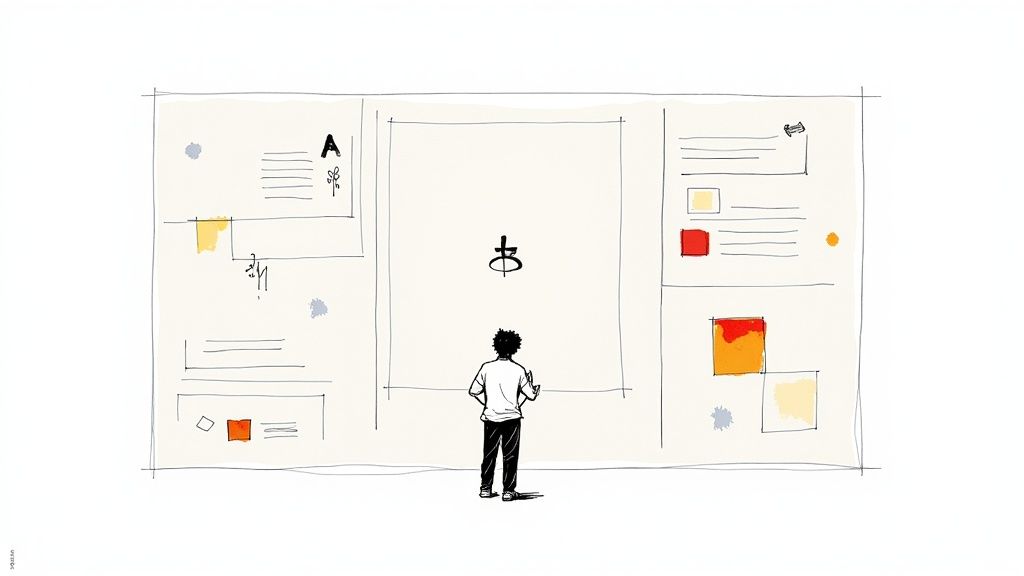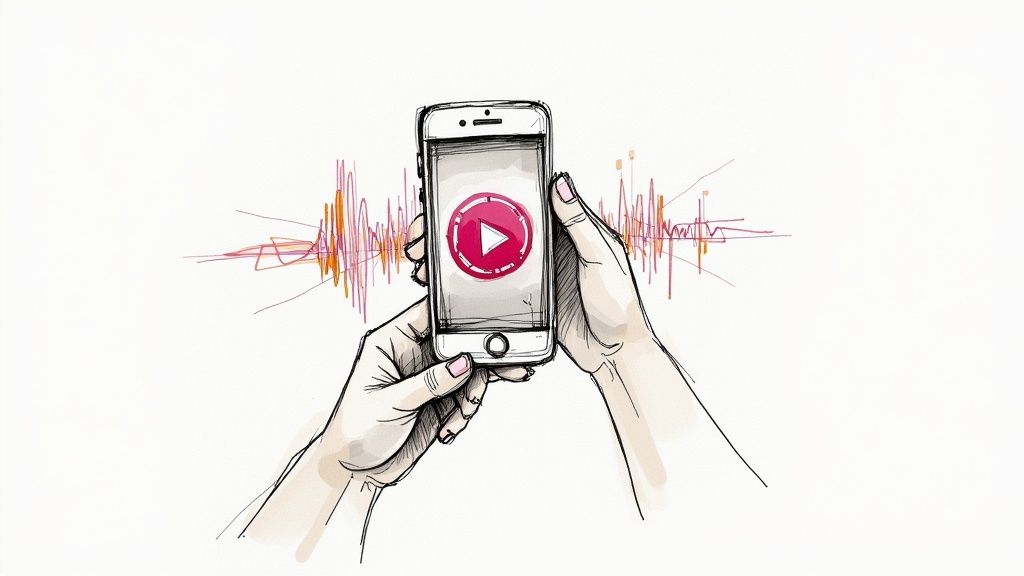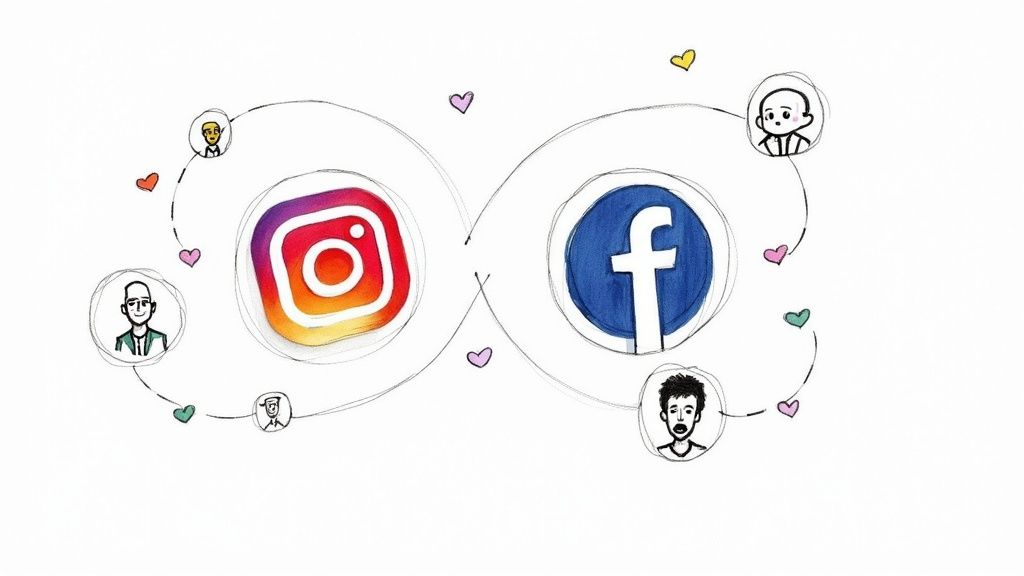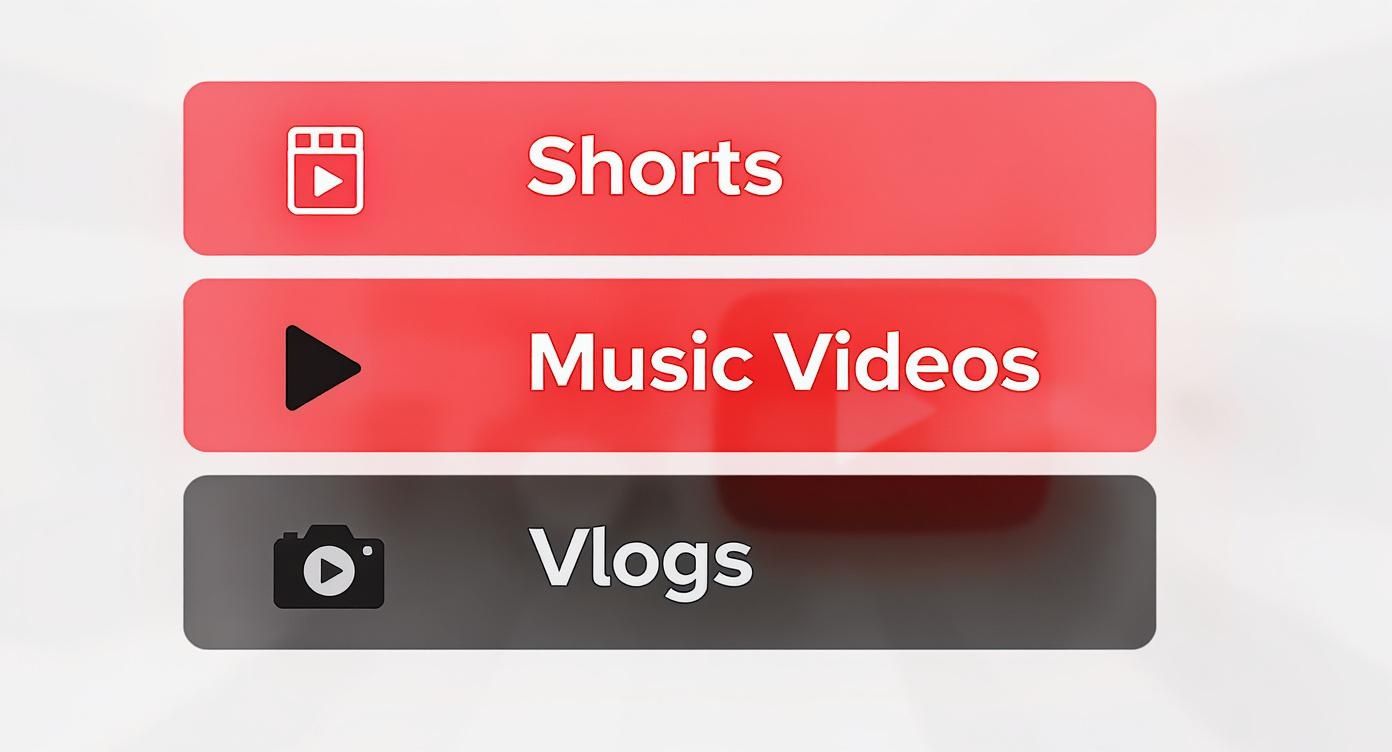Social Media Marketing for Music To Grow Your Fanbase
- gxurumusic
- 1d
- 14 min read
Before you even think about posting your next Reel or TikTok, we need to talk about the one thing that underpins all successful music marketing: your brand.
This isn't just about a cool logo or a color scheme. Your artist brand is your story. It’s the personality, the vibe, and the visual world you create that makes someone feel like they know you, not just your music. Get this right, and every piece of content you create will feel authentic and connected.
Crafting Your Artist Brand for Social Media

Think of your brand as the filter for every single marketing decision you make. Without it, you’re just throwing content at the wall, hoping something sticks. A solid brand identity is what cuts through the noise and makes you memorable.
It’s basically your artistic DNA—a mix of your genre, your personality, and the message at the heart of your music. Are you a defiant punk rocker? A soulful folk storyteller? An electrifying EDM producer? Your brand needs to scream that from every profile picture, bio, and caption you write.
Define Your Core Identity
First things first, you need to do a little soul-searching. Answering a few key questions will give you a clear roadmap for the kind of content that will resonate with the right people.
What’s my core message? Beyond the music, what do you stand for? What ideas or feelings keep showing up in your lyrics?
Who is my ideal listener? Forget basic demographics. What do they care about? What other artists are on their playlists? What online communities do they hang out in?
What makes me *different*? Get specific. Is it your unique vocal tone, your experimental production, or the raw honesty of your personal story?
This isn't about inventing a persona. It's about finding the most compelling parts of who you already are and turning up the volume. Fans connect with real people, and your brand is how they get to know the real you.
This identity becomes the foundation for everything, from your website to your press kit. Speaking of which, if you need to get your EPK in order, check out our guide on how to create an electronic press kit that gets noticed to make sure your branding is on point across the board.
Your brand is your promise to your audience. It tells them what they can expect from your music, your content, and your interactions. A consistent brand builds trust and turns casual listeners into dedicated fans.
To help you nail this down, here's a quick breakdown of the essential elements you'll want to define.
Core Elements of Your Artist Brand Identity
Brand Element | Key Questions to Answer | Example (Indie Folk Artist) |
|---|---|---|
Mission/Message | What is the central theme of your music? What do you want people to feel? | To create music that feels like a warm, quiet moment of reflection in a chaotic world. |
Personality/Voice | What three words best describe your persona? How do you talk to your audience? | Authentic, introspective, and witty. Communicates with vulnerability and humor. |
Visual Identity | What colors, fonts, and imagery represent your sound? What is your aesthetic? | Earth tones (olive green, terracotta), vintage film photography, natural landscapes, and handwritten fonts. |
Target Audience | Who are you making music for? What are their values and interests? | 20-35 year olds who love Bon Iver and Fleet Foxes, enjoy hiking, reading, and value authenticity. |
Unique Selling Point | What makes you stand out from other artists in your genre? | A unique fingerpicking style combined with deeply personal, narrative-driven lyrics. |
Once you've got these elements figured out, you're ready to start building your presence online.
Optimize Your Social Profiles for Impact
Now that you have a solid brand identity, it’s time to splash it all over your social media profiles. Consistency is everything—it’s how people start recognizing you instantly.
Use the same high-quality profile picture everywhere. Snag a consistent username or handle across all platforms. And write a bio that immediately tells people who you are and what your music sounds like.
This prep work is more important than ever. Streaming music revenue soared past $20 billion globally in 2024, and a staggering 80% of new listeners find music on social media. Even the platforms are getting in on it; tools like TikTok's Artist Account are designed to help musicians build their brand story, because they know it's what drives discovery and, ultimately, streams. You can get the full scoop on the latest industry numbers from the IFPI's Global Music Report.
Winning on TikTok as an Independent Artist

Let's be real: TikTok isn't just another app you can ignore. It's probably the single most powerful music discovery engine on the planet right now. Thinking of it as a chore or dismissing it as a silly dance app means you're leaving a direct line to millions of potential fans on the table.
The secret isn't about creating perfectly polished, high-budget music videos. That's not what works here. The content that truly hits is often raw, personality-driven, and maybe even a little messy. It’s about letting people into your world, one short clip at a time, and building a genuine community—not just chasing a one-off viral hit.
Forget Perfect, Embrace You
The best thing about TikTok? You don't need a massive production budget to make an impact. Your most powerful asset is your own unique story and personality. Honestly, some of the most effective music marketing happening on the platform comes from simple, relatable moments.
Start thinking about the stories behind your songs. A quick video explaining what a specific lyric means to you, sharing the chaotic process of nailing a chorus, or just talking about the real-life experience that sparked a track—that's the stuff that creates a real connection. It’s about showing the human behind the music.
By 2025, TikTok is on track to be the most influential platform for music marketing, period. This is happening because artists are finding new, authentic ways to reach massive audiences. The platform’s Artist Account even gives you tools like the Artist Tag and a dedicated Music Tab, making it way easier for people to find your entire catalog.
Just look at an artist like Beth McCarthy. She grew her following to over 820,000 by mixing authentic, story-driven content with a smart take on trends. It’s proof that genuine engagement is the winning formula. You can dive deeper into music promotion strategies for 2025 to see how other artists are crushing it.
Content Ideas That Actually Work
Stuck on what to post? The easiest approach is to document what you're already doing, not try to create some masterpiece from scratch. Weave content creation into your daily life as a musician.
Behind-the-Scenes Glimpses: Share short clips from writing sessions, studio time, or even just you noodling on an instrument. These moments feel exclusive to your fans and build real anticipation for new music.
Deconstruct Your Music: Isolate a killer bassline, a weird synth sound, or a tricky vocal harmony from one of your tracks. Show people how you made it. This is gold for fellow musicians and curious listeners.
Jump on Trends (Your Way): You don't have to do every dance challenge. Find a trending sound or format that actually fits your vibe. Use the Duet or Stitch feature to react to other creators, adding your own musical twist.
Tell Your Story: Talk about your journey. The struggles, the small wins, the awkward first gigs. Vulnerability is a superpower on TikTok.
Remember, every single video is a chance for someone to discover you for the first time. It doesn't need to be perfect; it just needs to be you. Consistency and authenticity will beat manufactured virality every time.
Ultimately, winning on TikTok means treating it like an ongoing conversation. Reply to comments, ask your followers questions, and make them feel like they're part of your inner circle. Every single interaction turns a casual viewer into a dedicated fan—the kind of fan who will be first in line to stream your next single.
Building Your Community with Instagram and Facebook

If TikTok is the handshake, then think of Instagram and Facebook as the deep conversations that follow. This is where casual listeners evolve into real fans. They go from just knowing your song to knowing you—and that's the difference between a listener and someone who buys merch, shows up to gigs, and tells their friends about your music.
This isn’t about chasing random discovery. It's about intentional community building. It’s your chance to give people a richer, more curated look inside your artistic world and nurture that initial spark of interest from a 15-second clip.
Mastering Your Instagram Presence
On Instagram, your profile grid is your visual album cover. It’s the first impression that instantly tells new followers what you're all about. You should aim for a cohesive aesthetic that actually feels like your brand, whether that’s moody black-and-white shots, vibrant high-energy candids, or a carefully designed color palette.
Your content strategy needs to be a mix of things that serve different goals:
Reels for Reach: Of course, you’ll use Reels to showcase your music, but give it a different angle than you would on TikTok. Think high-quality performance snippets, mini-music videos, or beautifully shot acoustic sessions. This is where you can present your music in a more polished format.
Stories for Authenticity: This is your daily vlog, the behind-the-scenes pass. Use Stories to share those unfiltered, day-in-the-life moments that people connect with. Show your songwriting process, run a Q&A from the back of the tour van, or use a poll to ask fans which song you should cover next. It feels personal and immediate.
Carousels for Storytelling: A carousel post is the perfect tool for telling a story. Drop a "photo dump" from a recent gig, give a step-by-step look at your recording setup, or share lyrics with some cool accompanying imagery.
And don't forget, your "link in bio" is your most valuable real estate. Seriously. Use a simple tool like Linktree or Beacons to create a landing page that funnels followers directly to what matters most: your Spotify profile, latest YouTube video, merch store, and tour tickets.
Don’t just post your music; invite people into the world where your music is made. The goal on Instagram isn’t just to be seen—it’s to be known and remembered.
Cultivating a Core Fanbase on Facebook
Yeah, its organic reach has changed over the years, but Facebook is still a beast for community management and targeted promotion. It’s especially powerful for connecting with an already established audience. Your focus here should be on creating a dedicated space for your most passionate supporters.
Creating a private Facebook Group for your fans is one of the most effective moves you can make. This isn't just another page; it’s an exclusive club. Inside the group, you can offer early access to tickets, share rough demos that no one else hears, and have direct conversations that just aren't possible on a public feed. It builds a sense of belonging and loyalty that’s tough to replicate anywhere else.
On top of that, Facebook's advertising platform is incredibly precise. You can run hyper-targeted ad campaigns to promote a new single or announce a local show, reaching people based on their listening habits, location, and even their engagement with similar artists. This makes every dollar you spend on ads way more efficient.
For a deeper dive into platform-specific tactics, our **music marketing social media playbook for artists** lays out more advanced strategies. The real key is to balance genuine, human interaction with smart, focused promotion.
Expanding Your Universe with YouTube Content
Think of YouTube as your own personal broadcast network, not just a place to park your official music video. Sure, a high-production music video is a massive cornerstone for any release, but building a whole ecosystem of content around it is what really turns casual viewers into loyal subscribers and, eventually, die-hard fans. It's about giving them reasons to stick around long after the song fades out.
You're essentially creating multiple doorways into your world. Not everyone will click with a cinematic, highly-produced video, but a raw, one-take acoustic performance of that same track? That might be exactly what captivates them. This approach builds a rich content library that shows off your artistry from every possible angle.
Building Your Content Library
The secret sauce here is variety. A winning YouTube strategy is about so much more than just the finished product. You've got to pull back the curtain and show the process, the personality, and the raw talent that goes into creating that polished final track.
Official Music Videos: This is your flagship. The main event. Plan the release, hype it up, and make it feel like a real moment. It’s the definitive visual for your song.
Lyric Videos: These are incredibly cost-effective and surprisingly engaging. A slick lyric video can pull in a whole different audience that wants to connect with your words, and they often kill it in search results.
Acoustic Sessions: Strip it all back. Filming a simple, intimate performance shows off your pure musicianship and gives your songs a fresh feel. These videos feel personal, almost like a secret show for your fans.
Behind-the-Scenes Vlogs: Take people along for the ride. Show them what it's like in the studio, on the road, or during a photoshoot. This kind of content builds a powerful story and makes your audience feel like they're part of the inner circle.
This mix ensures there's always something new for your audience to sink their teeth into, keeping your channel buzzing and active even between big releases.
Tapping Into Shorts and SEO
Don't sleep on YouTube Shorts. They are your secret weapon for discovery. Just like TikTok, the algorithm is designed to push this content far beyond your current subscriber list, putting you in front of tons of new faces. Use Shorts to drop quick performance clips, funny moments from the studio, or teasers for your longer videos.
A 15-second vertical clip from your acoustic session can act as a powerful trailer, driving viewers to the full-length video on your channel. This creates a funnel, turning short-form discovery into long-form engagement.
Finally, you have to pay attention to basic YouTube SEO. It sounds more complicated than it is. Just make sure your video titles, descriptions, and tags include your artist name, the song title, and any relevant keywords someone might type into the search bar to find music like yours (e.g., "indie folk acoustic," "lo-fi chillhop beat").
When you treat YouTube like a multi-format content hub, you create a much richer experience that truly rewards fandom. You're not just asking people to listen; you're inviting them into your creative universe and giving them endless reasons to subscribe and see what you do next.
Turning Social Buzz Into Streaming Growth
Likes, comments, and shares are great for social proof, but let's be real—they don't pay the bills. The real skill in social media marketing is turning that online buzz into cold, hard streaming numbers on Spotify and Apple Music. This is where you shift from just chasing attention to actually building a career.
A viral TikTok is an amazing launchpad, but it’s not the destination. That initial flood of interest is your golden opportunity, and it’s fleeting. Your next move has to be channeling all those new eyeballs directly to your streaming profiles with clear, impossible-to-miss calls-to-action (CTAs).
Bridge The Gap From Follower To Fan
You need to set up your social profiles for one thing: conversion. Make it dead simple for someone who just discovered your 15-second video to find your entire catalog. This is where a "link in bio" tool becomes your best friend, creating a one-stop landing page that points people straight to your music on all the major platforms.
Once that's in place, your content needs to do the heavy lifting of pushing people to that link. Don't just post a clip and hope for the best. Tell them exactly what to do next.
Run Pre-Save Campaigns: Before a new track drops, make a real event out of it. Hype up the pre-save link and maybe offer some exclusive behind-the-scenes content or a personal thank-you to everyone who signs up.
Drop Direct CTAs in Captions: Be blunt. Use language like, "My new single 'Midnight Drive' is finally out! Go stream it on Spotify at the link in my bio." No ambiguity.
Use Interactive Story Features: Get creative with Instagram's poll or question stickers. Ask fans about their favorite lyric, then immediately follow up with a swipe-up link to the song.
Think of your content as a funnel. This infographic breaks down how you can structure your content on a platform like YouTube to keep that funnel full.

This visual shows how a mix of short-form, discoverable content (Shorts), your main artistic statements (Music Videos), and more personal, behind-the-scenes stuff (Vlogs) all work together to build a complete ecosystem around your music.
Use Data To Drive Real Results
Here's where the magic really happens. When your social engagement drives people to stream your music, it sends a powerful signal to the algorithms on Spotify and Apple Music. These platforms are constantly collecting data on plays, skips, and playlist adds.
A sudden surge of traffic from social media tells the algorithm your track is catching fire, which can be the catalyst for landing on huge algorithmic playlists. You can learn more about how streaming data shapes music promotion from industry experts.
A viral moment gives you a temporary audience; a smart strategy turns them into long-term monthly listeners. The goal is to get them to hit 'follow' on Spotify, not just on Instagram.
This works both ways. You can also use your own streaming data to make your social media ads smarter. Seeing a sudden spike in listeners from a specific city? Great. Now you can run a targeted Facebook or Instagram ad campaign in that exact location to pour gasoline on the fire. This kind of data-driven approach means your marketing budget gets spent where it will actually make a difference.
Ultimately, turning that buzz into streams requires a conscious, deliberate effort to guide your followers. To dig deeper into this, check out our article on [proven tips to get more followers on Spotify](https://www.artist.tools/post/how-do-you-get-followers-on-spotify-proven-tips). Every single post should have a purpose, moving your audience one step closer to becoming dedicated listeners who don't just stumble upon your music—they actively seek it out.
Got Questions About Music Marketing? We've Got Answers.
Jumping into social media for your music can feel like stepping into a whole new world, and it's natural to have questions. Let's cut through the noise and get straight to what you need to know to build your audience and get your music heard.
How Much Should A New Artist Spend On Ads?
Look, you don't need a huge budget right out of the gate. It's all about being smart and testing the waters. I always tell new artists to start with an amount they genuinely won't miss—think $5 to $10 a day. Seriously.
Right now, your goal isn't to go viral overnight. It’s to collect data.
Put that small daily budget toward one single, clear objective. Maybe it's driving people to your pre-save link or boosting a 15-second clip of your track that's already doing well organically. Use the platform's targeting tools to find fans of artists who sound like you. Once you find an ad and an audience that clicks at a low cost, that's when you can confidently start putting more money behind it.
Do I Really Need To Be On Every Single Social Platform?
Absolutely not. In fact, please don't. This is one of the fastest routes to burnout, and you'll end up with a weak, scattered presence everywhere instead of a strong one somewhere.
It is so much more effective to dominate one or two platforms where your potential fans are already hanging out.
For music discovery right now, the undisputed champs are TikTok and Instagram. Focus on getting a solid, consistent workflow going for just those two. Once you're in a groove and seeing some real traction, then you can think about expanding. Maybe YouTube makes sense for longer videos, but only if you actually have the time and energy to do it right.
Trying to be everywhere is a recipe for being nowhere. Quality and consistency on two platforms will always crush sporadic, half-hearted posts on five.
How Do I Balance Making Music With Creating Content?
This is the big one, right? The secret is to stop seeing them as two separate jobs. Your music creation process is the content. You don't need to press pause on your art to become a marketer; you just need to document the journey.
Think of it this way:
Batch Your Work: Don't try to come up with something new every day. Set aside a couple of hours once a week. In that block, you can shoot a bunch of short clips, take some photos, and plan out your posts. A scheduling tool will feel like a superpower here.
Just Document: A quick video of you figuring out a lyric, messing with a new synth sound, or even just setting up mics for a recording session? That's gold for Instagram Stories or TikTok. People love seeing the real, unpolished work.
Repurpose Everything: That one-minute acoustic performance you filmed is not just one piece of content. It can be a full-length YouTube video, a 30-second Reel, and a 15-second TikTok clip. Work smarter, not harder.
This approach lets you stay focused on what really matters—the music—without feeling the constant pressure of "what am I going to post today?"
Ready to take the guesswork out of your Spotify strategy? artist.tools offers powerful analytics to track your streams, analyze playlists for bot activity, and find curator contacts to get your music heard. Take control of your music career today.
Comments